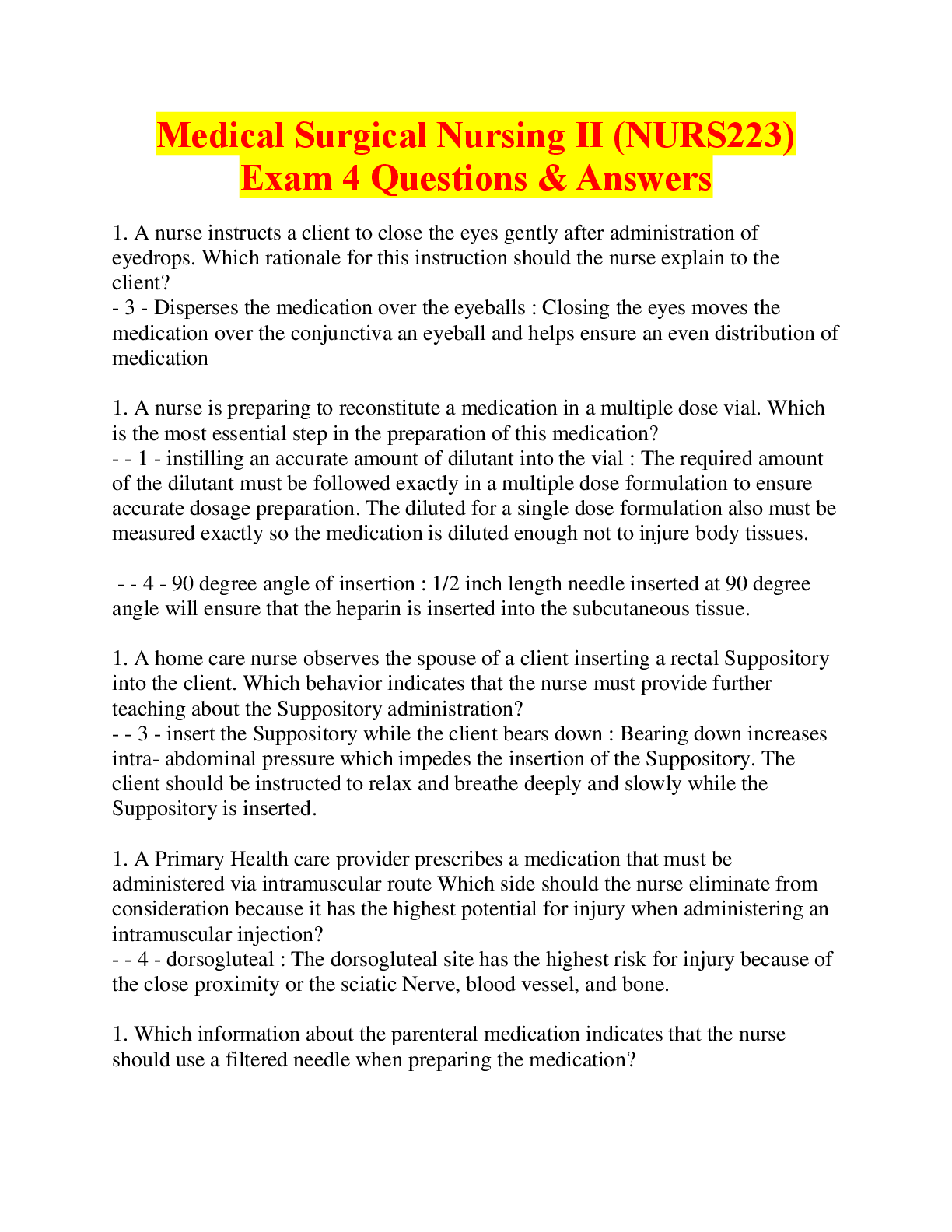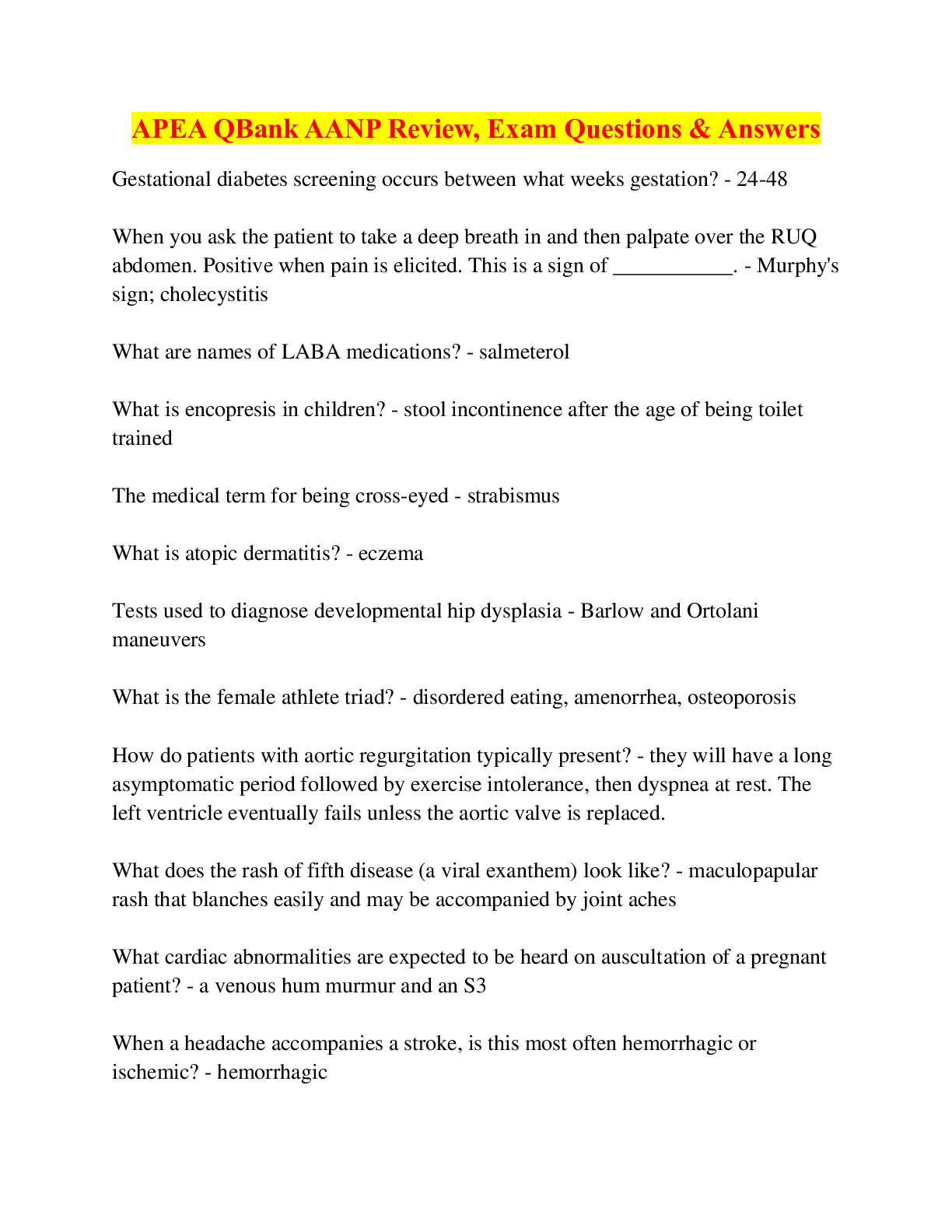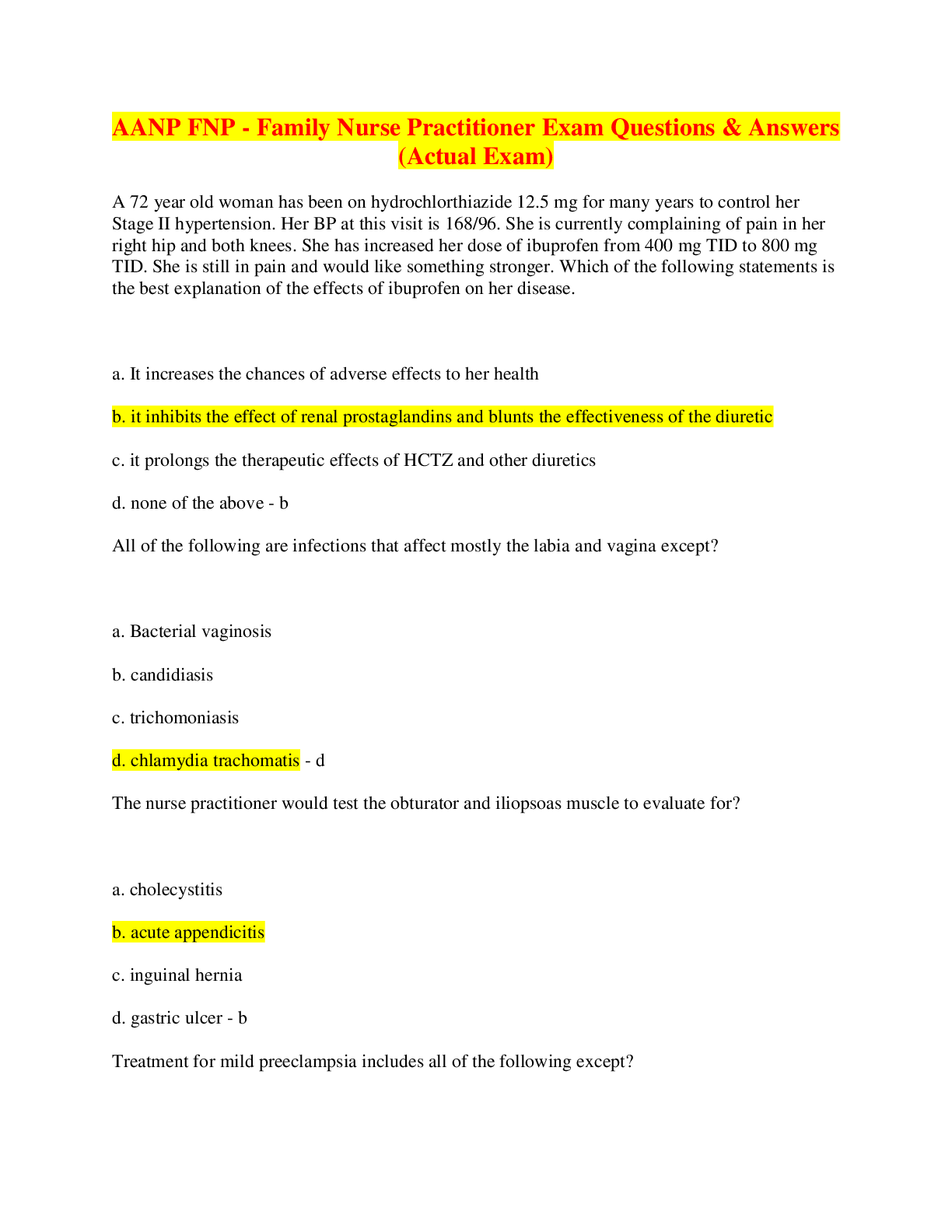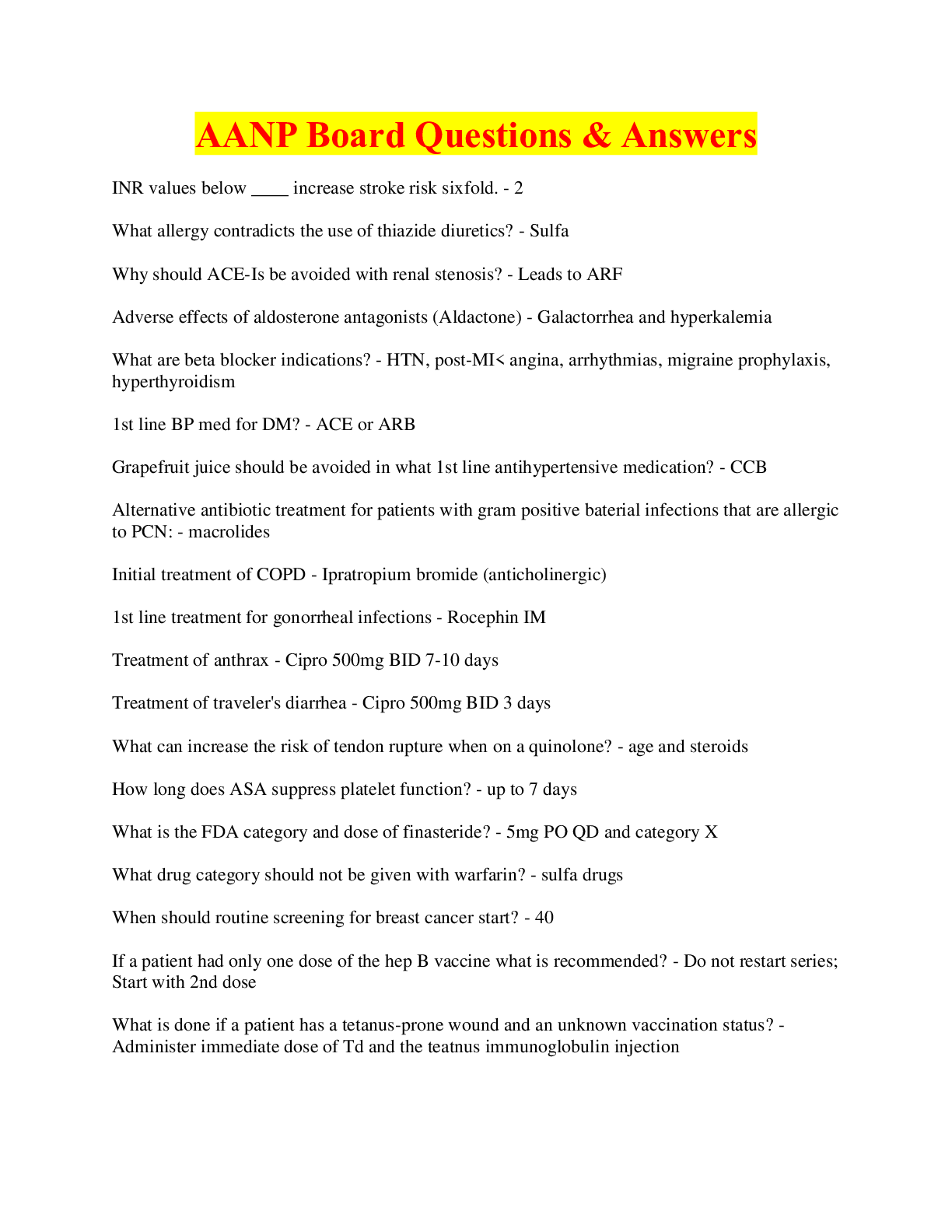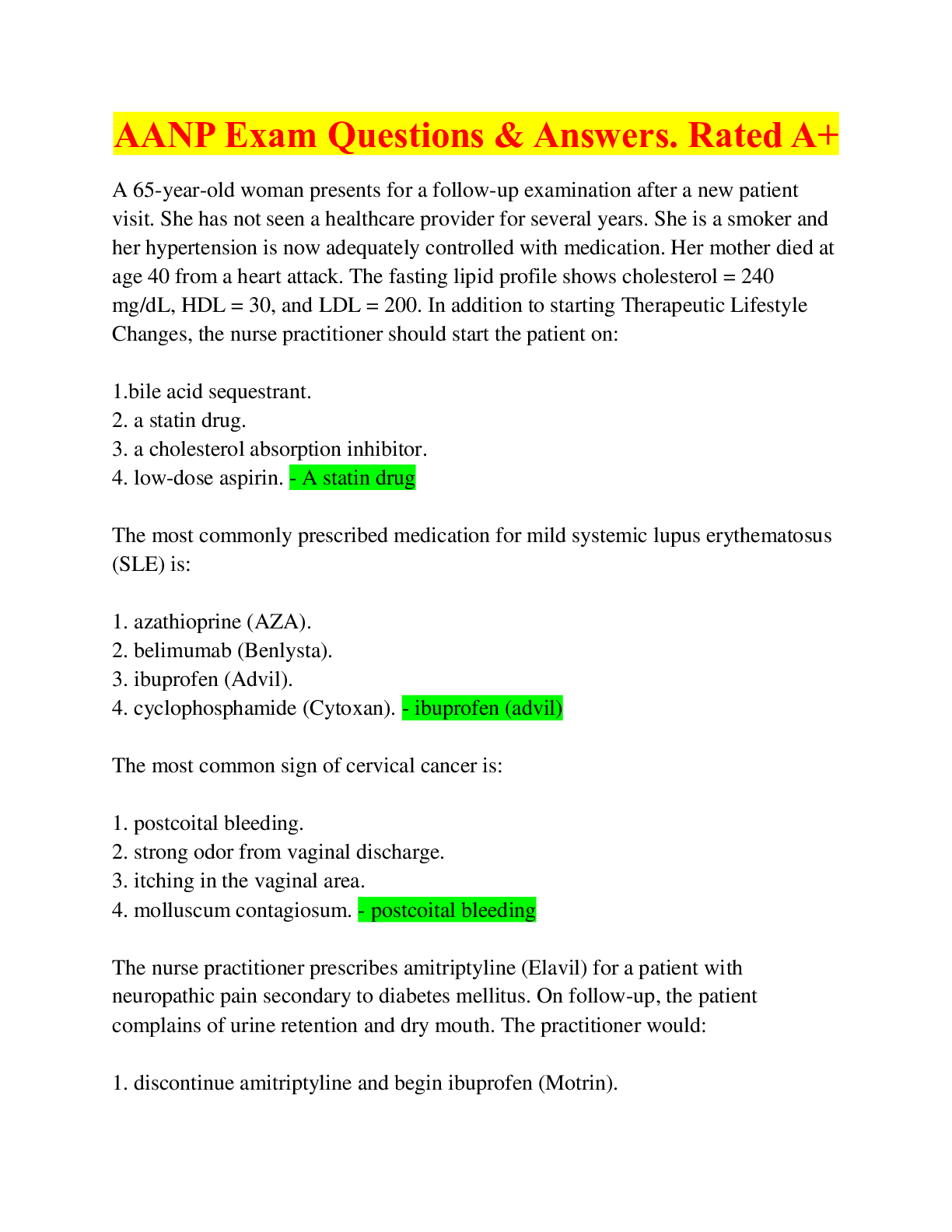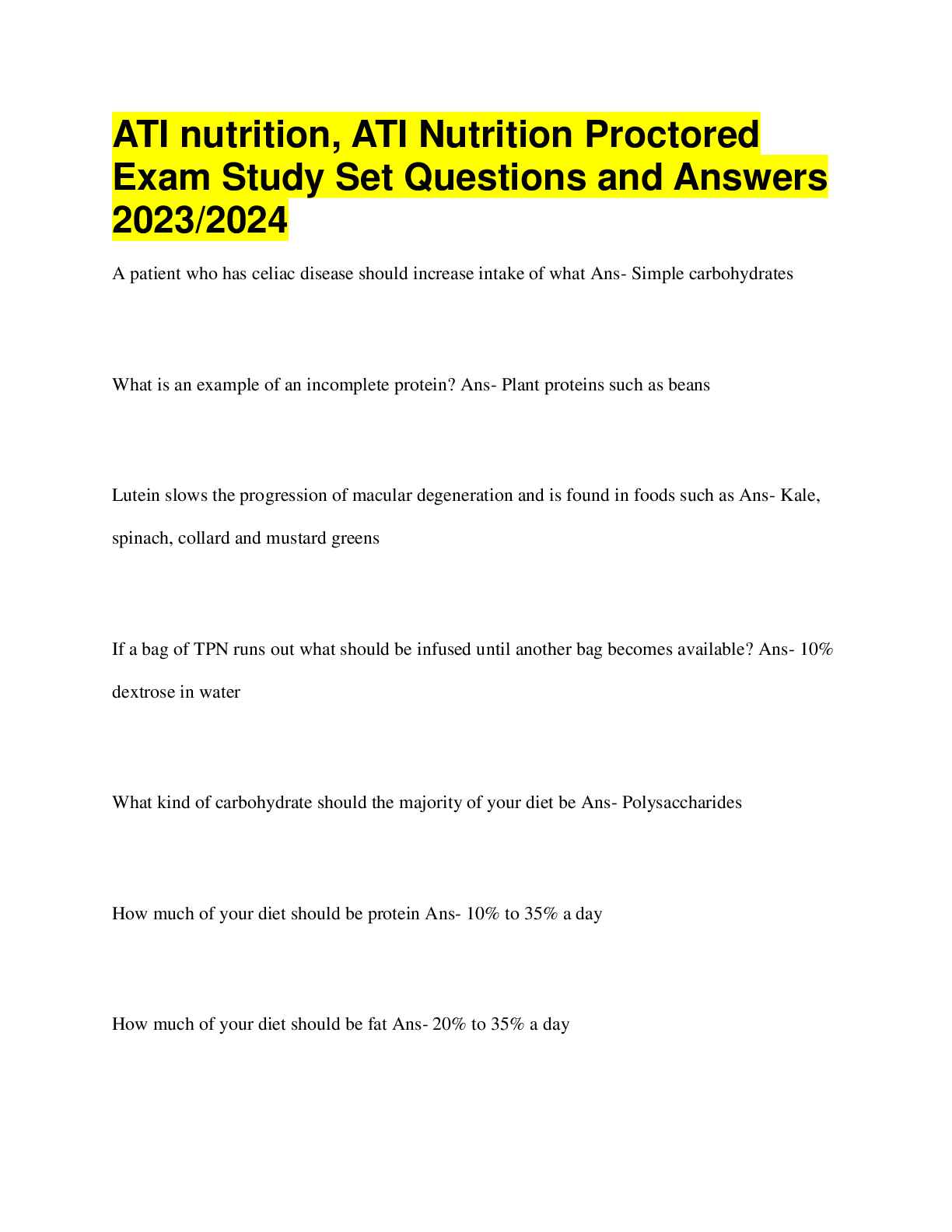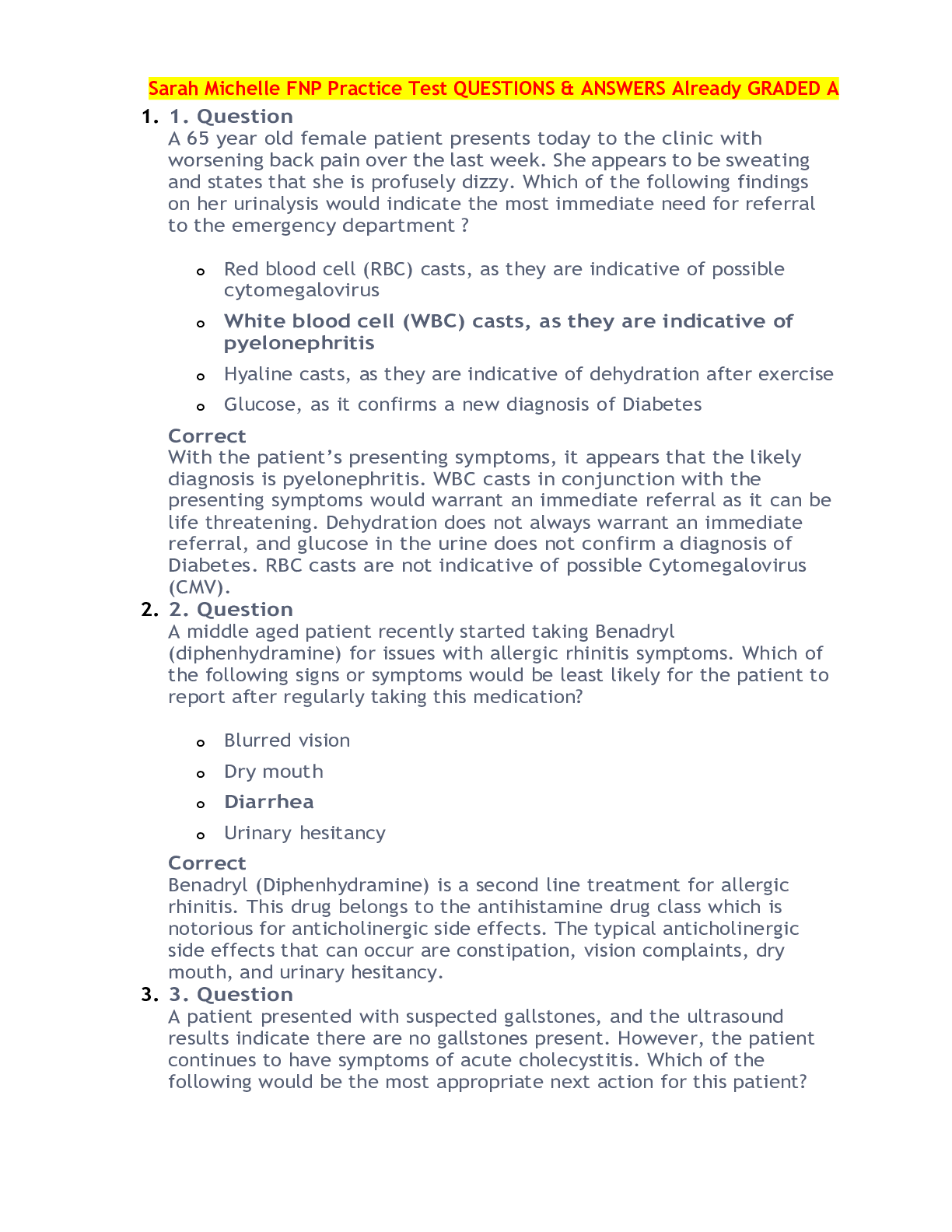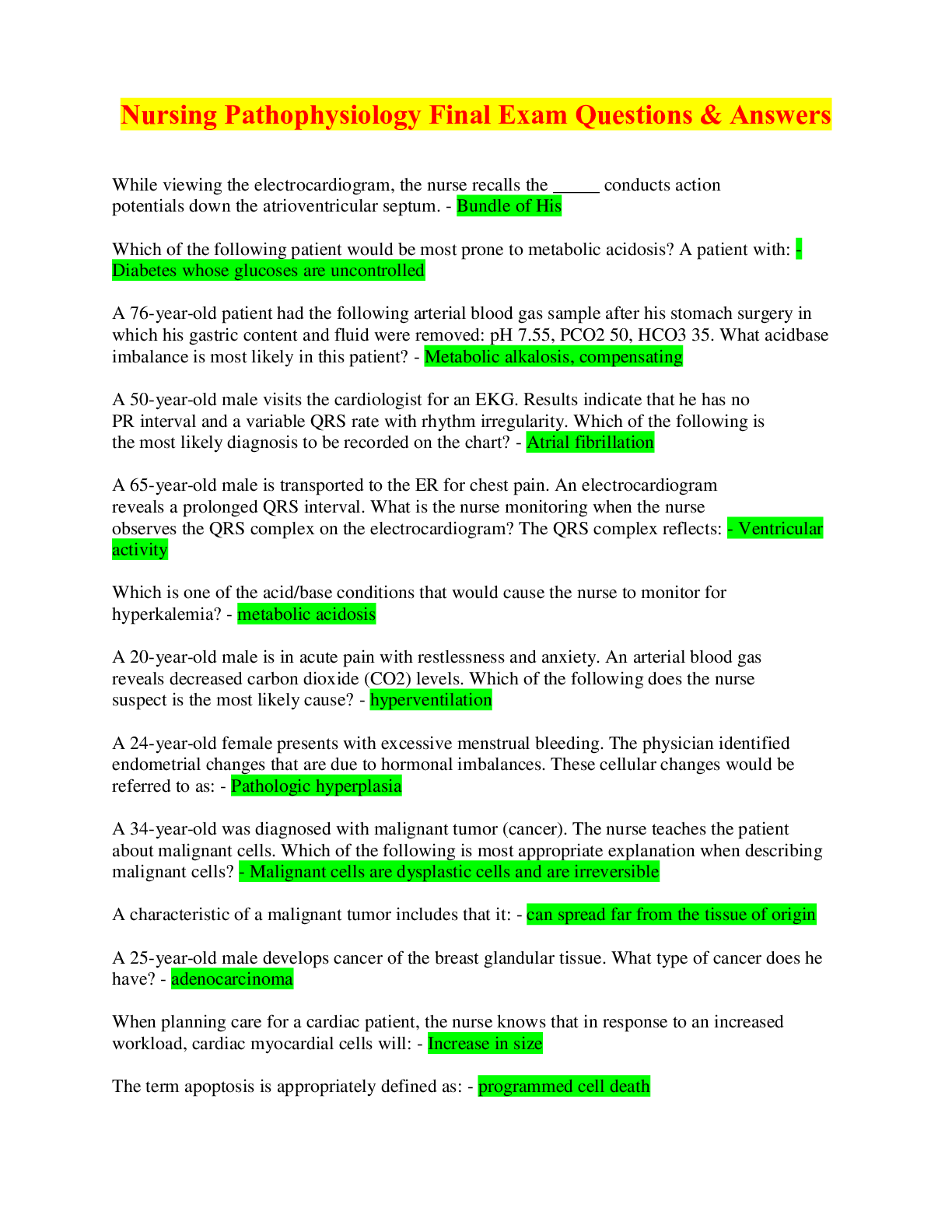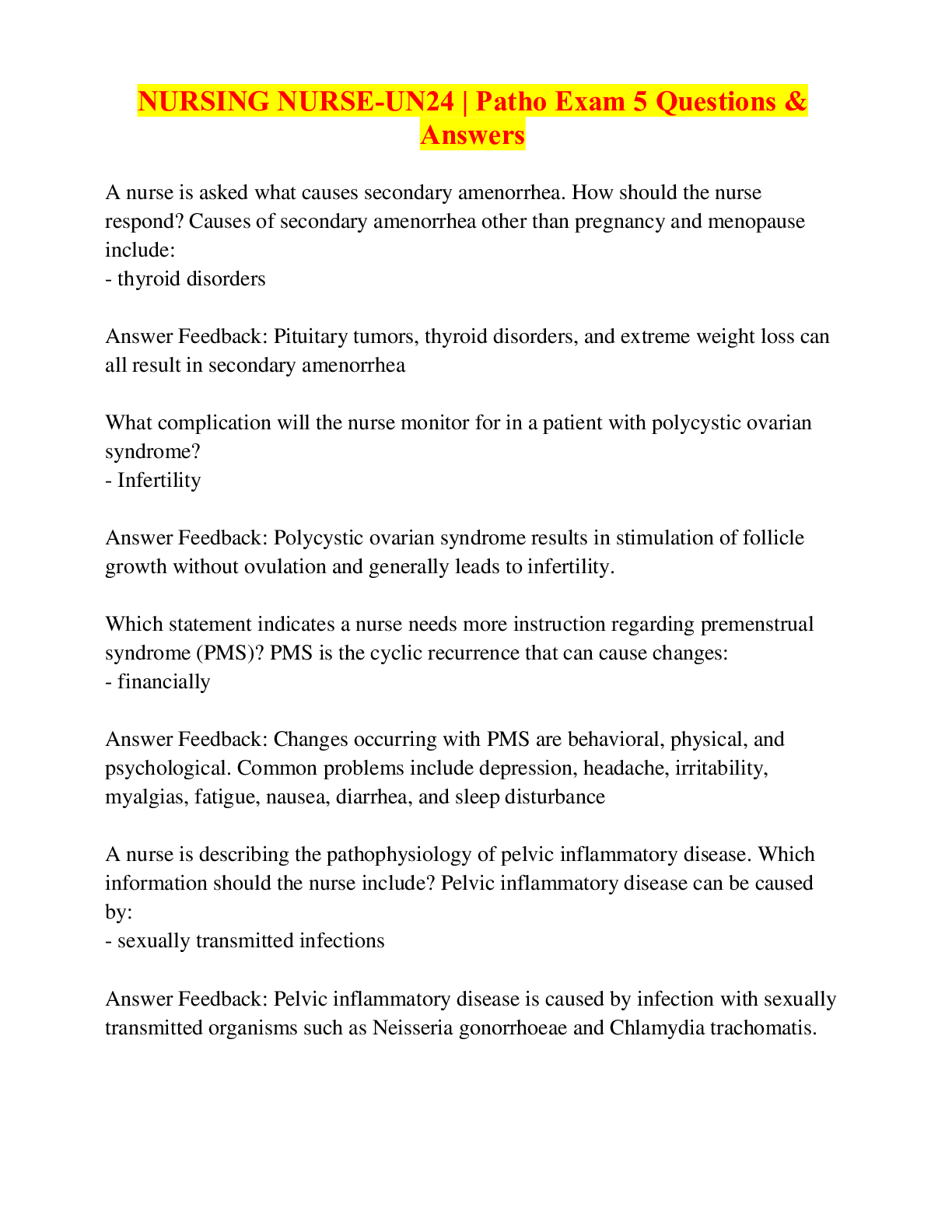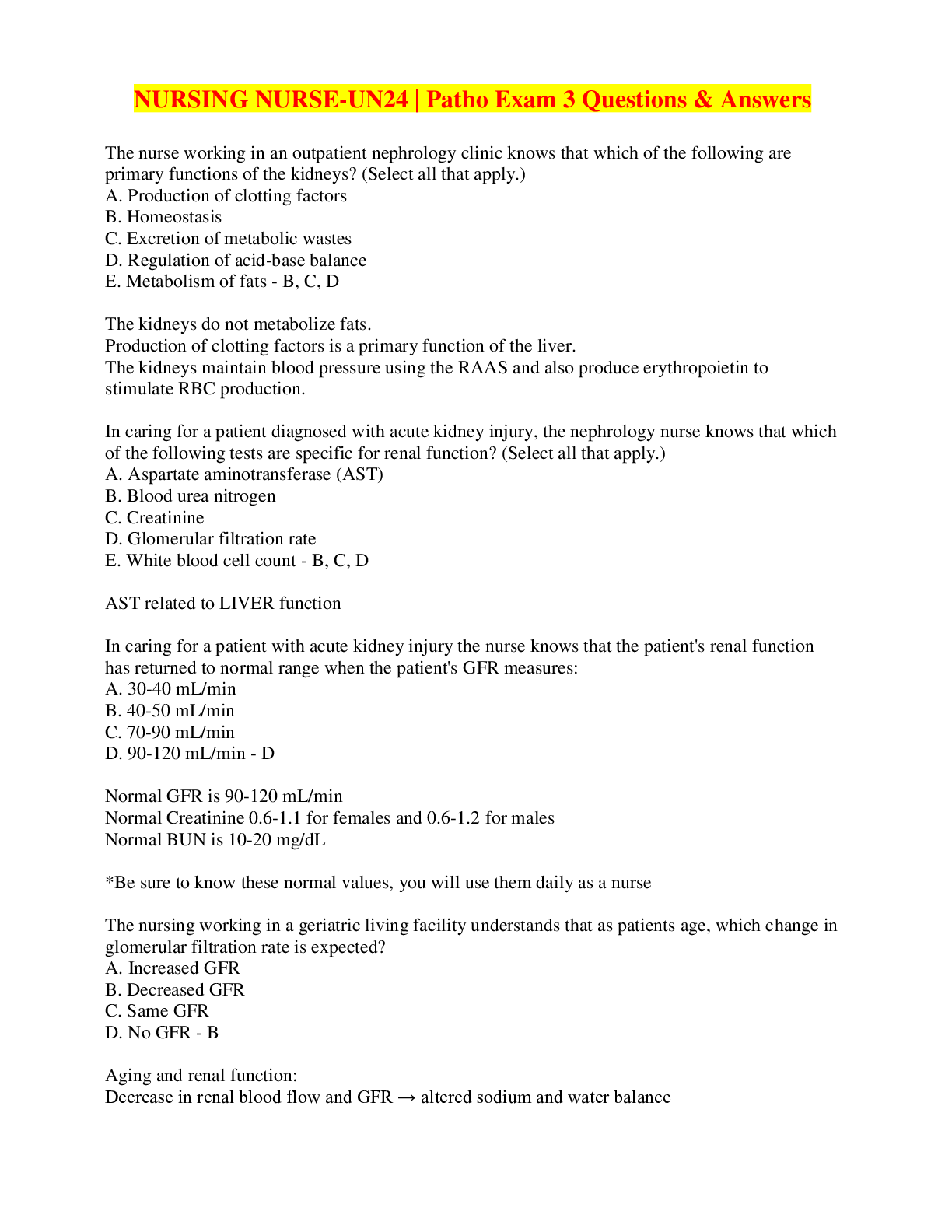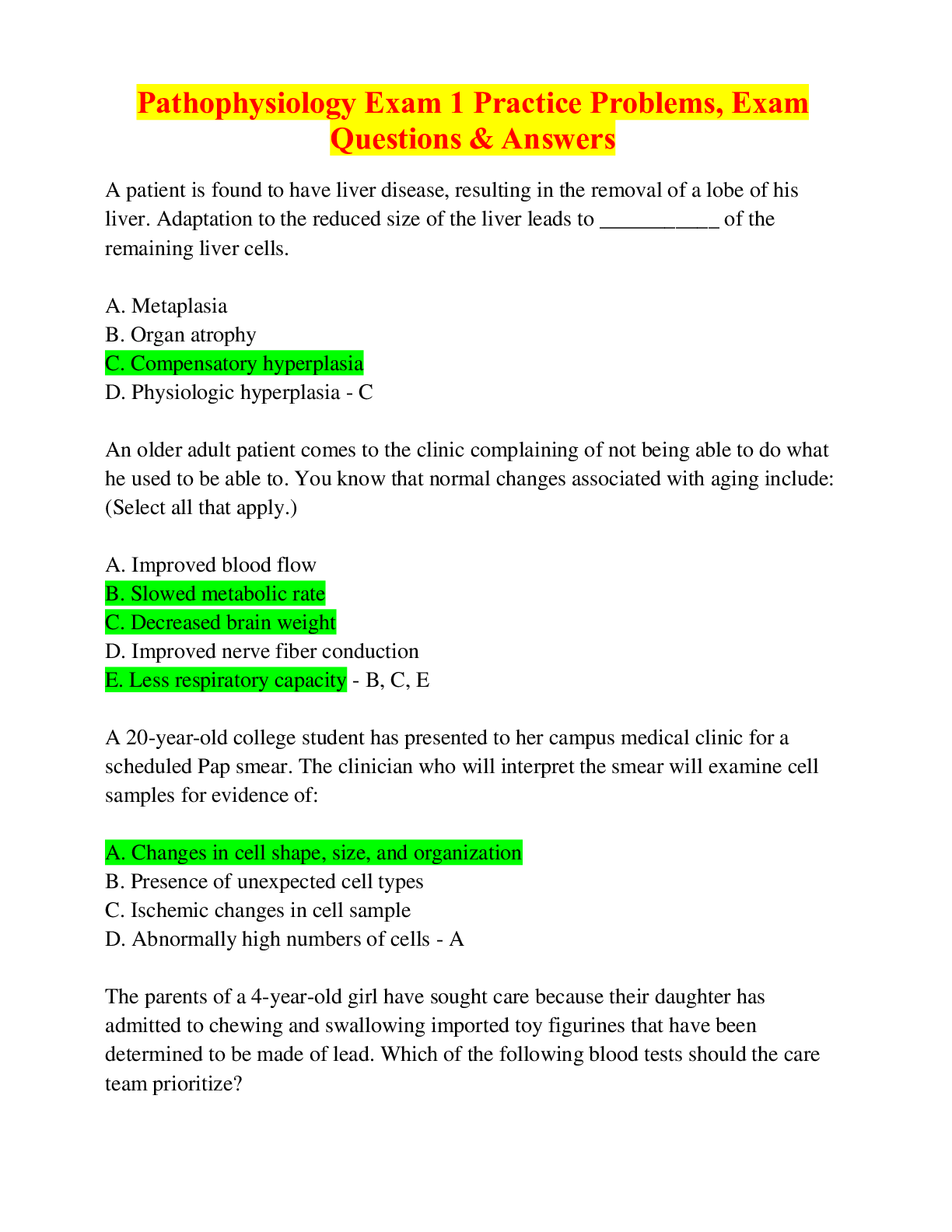HESI EXIT EXAM 2- 160 Questions and Answers (Solutions by a Verified Tutor)
Document Content and Description Below
HESI EXIT EXAM 2- 160 Questions and Answers (Solutions by a Verified Tutor) HESI EXIT EXAM 2 Questions & Answers TEST 2 Multiple Choice Identify the letter of the choice that best completes the statem... ent or answers the question. ____ 1. The nurse should question a prescription for docusate sodium (Colace) for a client with which problem? a. First day post myocardial infarction. b. Two days following a knee replacement. c. Abdominal pain of unknown etiology. d. History of liver disease. ____ 2. The nurse working on a medical unit is assigned to care for four clients. Which client should the nurse assess first? a. A client who is quadriplegic and is complaining of a severe headache. b. A client who had a stroke and now has right-sided weakness. c. A client who has a pressure ulcer and now has a temperature of 102.3° F. d. An elderly client who is requesting medication for constipation. ____ 3. A male client is accompanied to the emergency department by the police after trying to jump off a bridge. As the nurse begins the initial evaluation, what is the priority assessment? a. Assess to see if the client is having command hallucinations. b. Determine where the client usually seeks healthcare treatment. c. Assess if the client has a history of aggression. d. Determine if the client has a history of depression. ____ 4. Prior to discharge, the parents of a child with cystic fibrosis are demonstrating chest physiotherapy (CPT) that they will perform for their child at home. Which action requires intervention by the nurse? a. A bronchodilator is administered before starting CPT. b. The child is placed in a supine position to begin percussions. c. A cupped hand is used when percussing the lung fields. d. Plan to perform CPT when the child awakens in the morning. ____ 5. A client at 29-weeks gestation is receiving magnesium sulfate 3 grams/hour for pre-term labor. After administering the loading dose, what assessment finding should the nurse report to the healthcare provider immediately? a. A decrease in respirations from 20 to 17 breaths/minute. b. An increase in temperature from 98.9° to 99.9° F. c. An increase in blood pressure from 110/65 to 120/85. d. A decrease in deep tendon reflexes from 3+ to 1+. ____ 6. Based on the change of shift report, the client with which signs and symptoms should be assessed by the nurse first? a. Epigastric pain, no bowel sounds. b. Chest pressure, diaphoresis, nausea. c. Chest tightness, wheezing, coughing. d. Calf pain, positive Homan's sign. ____ 7. A client who is diaphoretic and talking incoherently presents in the emergency department triage area. What assessment should the triage nurse obtain first? a. A finger-stick glucose. b. A blood pressure. c. Temperature d. Arterial blood gases. ____ 8. A 59-year-old male client is brought to the emergency room where he is assessed to have a Glasgow Coma Scale of 3. Based on this assessment, how should the nurse characterize the client's condition? a. He is in a coma, and has a very poor prognosis. b. This client is conscious, but is not oriented to time and place. c. He has a good prognosis for recovery. d. The client has increased intracranial pressure. ____ 9. Three days postoperative, a client's wound drainage changes in appearance from sanguineous to serous. Based on this finding, what nursing intervention should the nurse implement? a. Continue to monitor the wound. b. Monitor the client's vital signs. c. Apply pressure to the wound. d. Obtain a wound culture. ____ 10. A client with heart failure has developed a large pleural effusion and the healthcare provider plans to perform a thoracentesis. In preparing the client for this procedure, what intervention should the nurse implement? a. Notify the operating room personnel to schedule the procedure. b. Contact the client's next of kin to sign the operative consent. c. Determine if the client is allergic to antibiotics. d. Instruct the client to remain immobile during the procedure. ____ 11. A young adult male client is admitted to the emergency room with a bleeding abdominal wound following a motor vehicle collision. He is crying out with pain. His friends report that he often uses cocaine. What nursing diagnosis has the greatest priority? a. High risk for injury related to cocaine withdrawal. b. High risk for injury related to hemorrhage. c. Pain related to injuries. d. Anxiety related to trauma of motor vehicle accident. ____ 12. Which action should the nurse take first when performing tracheostomy care? a. Cleanse around the stoma. b. Suction the tracheostomy. c. Oxygenate with 100% oxygen. d. Secure the new neck strap. ____ 13. Which assessment finding would indicate to the nurse the need for intramuscular administration of vitamin K to a client with cirrhosis? a. Hemoccult positive stool. b. Anorexia and nausea. c. Increasing ascites. d. Decreased level of consciousness. ____ 14. Prior to removing the upper plate of a confused client to perform denture care, which action should the nurse take? a. Scrub the dentures with a foam swab. b. Move the plate up and down slightly. c. Fill the denture cup with hot water. d. Carefully insert an oral airway. ____ 15. A 45-year-old female client who had a hysterectomy one week ago asks the nurse when she will start to experience hot flashes. Before responding to the client's question, what information should the nurse obtain? a. The reason why the hysterectomy was performed. b. The type of birth control used preoperatively. c. Whether the client's ovaries were also removed. d. The type of hysterectomy that was performed. ____ 16. A 68-year-old male client is admitted to the medical unit, and one of his nursing diagnoses is, "Altered urinary elimination." The nurse knows that acute renal failure may be due to a variety of causes that can be classified as prerenal, renal, and postrenal. What is an example of a causative factor that is classified as "renal?" a. Hemorrhage from a chest wound. b. Malignancy of the kidneys. c. Renal calculi blocking the ureters. d. Benign prostatic hypertrophy. ____ 17. When developing a teaching plan on tuberculosis, which information would be accurate for the nurse to include? a. Those with a positive tuberculin test can expect to eventually develop active tuberculosis. b. Isoniazid (INH) is the drug of choice for prevention therapy. c. A slightly elevated temperature at mid-morning is a cardinal sign of tuberculosis. d. A tuberculin skin test should be read 24 hours after administration. ____ 18. Following a vaginal delivery, a postpartum client complains of severe cramping after breastfeeding her newborn. Which explanation describes the most likely reason for the client's pain? a. A retained placenta. b. Problems with the process of involution. c. The release of oxytocin hormone. d. A possible ileus. ____ 19. What nursing diagnosis has the highest priority for a client with severe ascites as a result of liver disease? a. Sleep pattern disturbance. b. Body image disturbance. c. Ineffective breathing pattern. d. Fear of dying. ____ 20. The nurse obtains a blood sample from a gravid client for determination of alpha-fetoprotein (AFP). What information will this laboratory value provide? a. Determination of the existence of spina bifida. b. Screening for possible neural tube defects. c. Determination of fetal lung maturity. d. Screening for Tay-Sachs disease. ____ 21. A hospitalized client with peripheral arterial disease (PAD) is instructed regarding leg and foot care. Which statement by the client indicates to the nurse that effective learning has occurred? a. "I will use my swimming pool early in the day while the water is still very cool." b. "Whenever I am sitting in a chair I will keep my legs up to reduce swelling." c. "I will try to keep moving if leg pain occurs to help promote good circulation." d. "I can use a mirror to check the bottoms of my feet for any signs of breakdown." ____ 22. A 14-year-old male client arrives at the emergency room in status epilepticus. He was diagnosed with a seizure disorder in childhood. What is the most likely cause of his present condition? a. Increasing intracranial pressure. b. Acute withdrawal from anticonvulsant medication. c. A closed head injury. d. A central nervous system infection. ____ 23. A 75-year-old female client had a total hip replacement two days ago. She has never been in the hospital before. She has just called for the bedpan. How should the nurse place the pan under this client? a. Ask her to grab her overbed trapeze, push both heels into the mattress, and raise her buttocks off the bed so the bedpan can be slipped under her. b. Ask her to roll to the unoperated side and slide the bedpan under her, then roll her back onto the pan. c. Ask her to roll to the operated side and slide the bedpan under her, then roll her back onto the pan. d. Ask her to flex her knees, spread her legs, and lift her buttocks with the flat part of her feet, then push the bedpan under her from the front. ____ 24. In caring for a client who is receiving peritoneal dialysis, the nurse should be alert for what complications? a. Abdominal pain, tenderness, and rigidity. b. Clear dialysate drainage and burning on urination. c. An occluded vascular access device and flank pain. d. Increased serum albumin level, decreased BUN, and increased hematocrit. ____ 25. A nurse seeks to alter a provision of a state's Nurse Practice Act regarding nurse-client ratios, which the nurse believes to be unsafe. What action is most likely to impact a ruling by the state's Board of Nursing? a. Send an anonymous letter of concern to the local newspaper. b. Meet with the nurse's representative to the state legislature. c. Send documentation of the problem to the American Nurses' Association. d. File a grievance at the medical center where the nurse is employed. ____ 26. While teaching a female Korean-American client about her medications, the nurse observes that she appears very serious, does not smile, and avoids looking at the nurse. Which expected outcome statement best directs this client's plan of care? The client will a. express her feelings of anxiety/fear. b. be relaxed and confident about her medication regimen. c. state that she understands her medication regimen. d. describe her medication regimen correctly. ____ 27. A client newly diagnosed with Type 1 diabetes received 28 units of Humulin N at 0700. The nurse is making rounds at 1330. Which client statement requires the most immediate follow-up intervention by the nurse? a. "I get so nervous when I have to give my shot." b. "I didn't sleep well last night. I am going to take a nap." c. "I get dizzy when I get up out of the bed too fast." d. "I let my wife eat my lunch since I wasn't hungry." ____ 28. The nurse has identified four nursing problems for a 13-year-old admitted for depression and anxiety. What is the priority problem? a. Ineffective health maintenance related to substance abuse and unsafe sex. b. Risk for self-directed violence related to history of self-mutilation. c. Ineffective coping related to post-traumatic stress of fire that killed siblings. d. Knowledge deficit regarding purpose of medications and side effects. ____ 29. A client diagnosed with nephrotic syndrome is treated with the glucocorticoid steroid prednisone (Cortef). The nurse recognizes that the treatment is having the desired effect when the client exhibits which serum lab value? a. Increased serum magnesium. b. Increased glycosuria. c. Decreased serum albumin. d. Decreased proteinuria. ____ 30. The nurse assesses a newborn who experienced shoulder dystocia. An asymmetric response to which developmental reflex could indicate clavicular fracture? a. Moro b. Trunk incurvation. c. Rooting. d. Tonic neck. ____ 31. The nurse is evaluating an asthmatic client's response to an inhaled corticosteroid medication. What assessment finding indicates that the medication has been effective in controlling the asthma symptoms? The client has increased a. peak flow meter rates. b. retraction of the chest muscles. c. viscosity of tracheal secretions. d. volume of expiratory wheezes. ____ 32. The drainage from a client's colostomy changes from light yellow-brown to a black tarry appearance. What serum lab values are most important for the nurse to monitor? a. Sodium and Potassium. b. WBC count and Differential. c. Hemoglobin and Hematocrit. d. Creatinine and BUN. ____ 33. A 28-year-old client is in the emergency room following a spinal cord injury (SCI) at the T4 level. The nurse should frequently assess for spinal shock by assessing for which signs and symptoms? a. Bradycardia and hypotension. b. A narrow pulse pressure. c. Cool skin and an elevated SVR. d. Distended neck veins and an elevated CVP. ____ 34. Which nursing diagnosis has the highest priority when caring for a client receiving methylprednisolone (Solu-Medrol)? a. Body image disturbance related to cushingoid appearance. b. Altered nutrition, greater than body needs related to increased appetite. c. Self-care deficit related to muscle wasting. d. Risk for infection related to immunosuppression. ____ 35. A client needs to take 1.2 grams of calcium daily. The client currently takes eight 200 mg tablets each day. What instruction should the nurse provide? a. Reduce the daily dose by two tablets. b. Take half as many tablets. c. Continue with the current daily dose. d. Take two additional tablets daily. ____ 36. A female client tells the nurse how happy she is that her family brought a small bag of home-grown herbs to the hospital and placed them under her pillow. What action should the nurse take? a. Remove the herbs from under the pillow for proper disposal. b. Discuss why herbs are not allowed in a healthcare facility. c. Direct the family member to the charge nurse before leaving the herbs. d. Inquire about the intended purpose of placing the herbs under the pillow. ____ 37. When conducting a nursing assessment of a client with a nasal fracture, which finding is most significant? a. Diminished sense of smell. b. Localized pain and tenderness. c. Clear fluid draining from the nose. d. Bilateral ecchymosis. ____ 38. A low phenylalanine diet is prescribed for a 4-year-old with phenylketonuria. The nurse evaluates that the mother understands her child's dietary restrictions if she eliminates which food from the child's diet? a. Sliced apples. b. French fries. c. Fruit juices. d. Cheese sandwich. ____ 39. On the fourth hospital day following abdominal surgery, a male client complains of right calf pain, and becomes restless and disoriented. Vital sign assessment reveals tachycardia and dyspnea. The nurse suspects development of a pulmonary embolism (PE). Which additional assessment findings indicate that a pulmonary embolism has occurred? a. Fever and inflammation of the abdominal incision. b. Chest pain and an increase in the respiratory rate. c. Increased severity of abdominal pain and hypotension. d. Positive Homan's sign and diminished left pedal pulse. [Show More]
Last updated: 2 years ago
Preview 1 out of 46 pages

Buy this document to get the full access instantly
Instant Download Access after purchase
Buy NowInstant download
We Accept:

Reviews( 0 )
$19.50
Can't find what you want? Try our AI powered Search
Document information
Connected school, study & course
About the document
Uploaded On
Mar 30, 2021
Number of pages
46
Written in
Additional information
This document has been written for:
Uploaded
Mar 30, 2021
Downloads
1
Views
158


